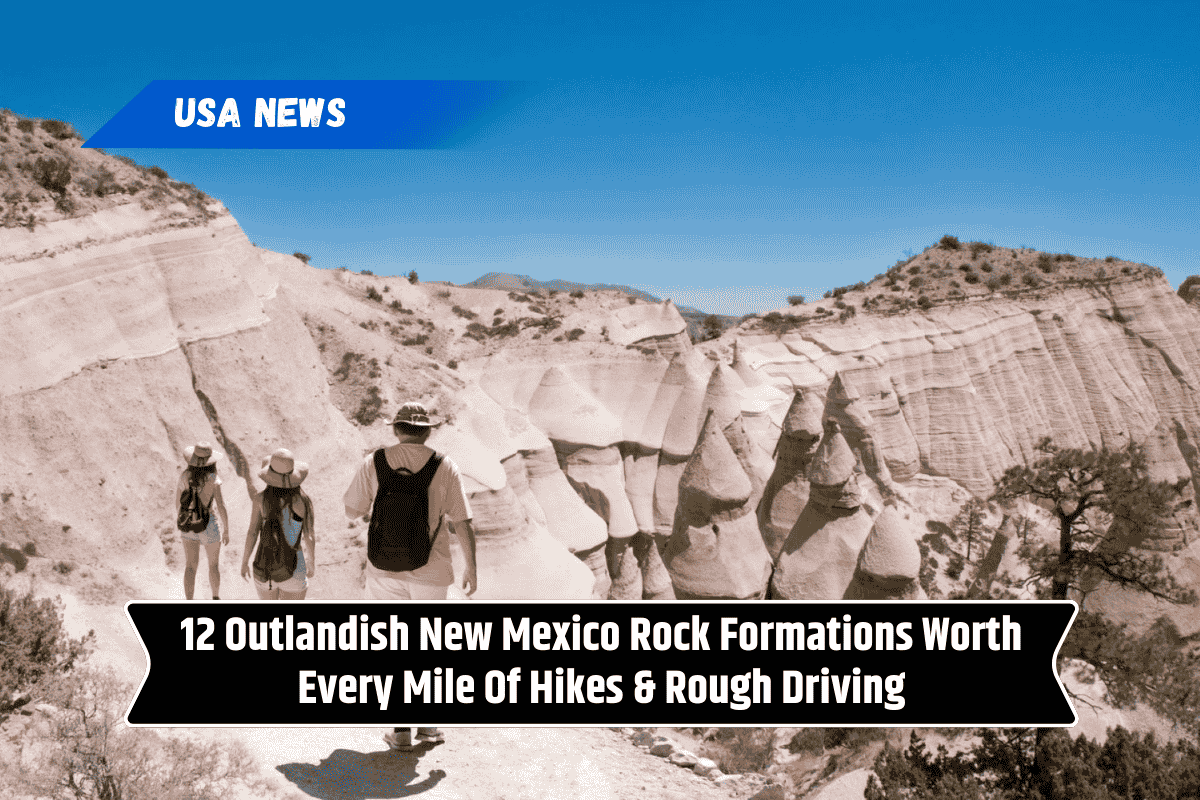New Mexico is a treasure trove of jaw-dropping natural beauty, and its rock formations are some of the most outlandish and mesmerizing in the country. From towering spires to rainbow-colored canyons, these otherworldly formations will make any hike or rough drive worth it.
Here are 12 of the most awe-inspiring rock formations in New Mexico that you won’t want to miss.
1. Tent Rocks (Kasha-Katuwe Tent Rocks National Monument)
Located about 40 miles southwest of Santa Fe, Tent Rocks is one of New Mexico’s most famous geological wonders. The area is filled with conical rock formations that look like giant tents, formed by volcanic eruptions millions of years ago.
Hike through the narrow slot canyons to reach the top for stunning views of these bizarre rock spires.
2. Bandelier National Monument
Bandelier is known not just for its ancient cliff dwellings but for its dramatic volcanic rock formations that create a stunning backdrop. The soft volcanic tuff here erodes into formations like the famous “cave dwellings” where ancient Puebloans once lived.
The rocky landscape is perfect for hiking, climbing, and exploring, with mesmerizing views of mesas and canyons.
3. Shiprock
A towering, sacred formation rising 1,500 feet above the surrounding desert, Shiprock (Tsé Bit’a’í) is one of New Mexico’s most recognizable and iconic rock formations. Located on Navajo land, this towering volcanic neck is steeped in cultural significance and is often photographed for its stark, otherworldly beauty.
While climbing the formation is not permitted, you can still take in its splendor from the nearby highway.
4. The Painted Desert
This vast desert landscape in northeastern New Mexico is famous for its colorful rock layers, which appear to be “painted” in vibrant hues of red, orange, purple, and yellow.
The striking beauty of the Painted Desert can be best appreciated from the numerous lookouts along Interstate 40, but to truly immerse yourself in the area, explore the surrounding Petrified Forest National Park, where ancient, fossilized trees are also on display.
5. El Malpais National Monument
El Malpais features dramatic volcanic landscapes, including lava tubes, volcanic cones, and craggy rock formations. One of the most fascinating aspects of the park is the “El Calderón” lava flow area, where you can hike across fields of black basalt rocks and into caves created by ancient lava flows.
The contrast between the black lava rocks and the surrounding desert landscape makes it an otherworldly experience.
6. La Cienega
La Cienega features layered sedimentary rock formations that stretch across mesas and valleys. The landscape is dotted with striking formations that look like ancient stone buildings.
The area is great for hiking, with plenty of paths leading you past eroded rock spires and through varied terrain. The area’s vibrant colors during sunrise or sunset add to the surreal beauty.
7. Chaco Canyon
Chaco Canyon was once a major center of the ancient Ancestral Puebloans, and today, it’s home to some of the most incredible rock formations in New Mexico. The canyon’s towering cliffs, narrow canyons, and stone ruins are set against a backdrop of jagged rock formations.
You can hike through the canyon to see these ancient geological wonders up close while learning about the cultural history of the area.
8. The Organ Mountains
Located just outside Las Cruces, the Organ Mountains are a dramatic and rugged range that rises steeply from the desert floor. These towering spires, made of jagged limestone, resemble the pipes of an organ, and their beauty is particularly striking at sunrise or sunset.
The area offers plenty of rugged hiking and climbing opportunities for adventurous visitors.
9. Valley of Fires
Valley of Fires, located in southern New Mexico near Carrizozo, is a volcanic landscape where lava flows have hardened into strange and stark formations.
This area features blackened lava beds that stretch across the landscape, creating a stark contrast to the surrounding desert. The surreal beauty of the valley is enhanced by the quiet solitude of the environment.
10. The Sandstone Cliffs of the San Juan River
The San Juan River cuts through a beautiful canyon lined with colorful sandstone cliffs that range from deep reds to soft purples and browns. The area is remote but worth the visit for those interested in exploring by boat or taking a long, scenic drive through the canyon.
The striking color contrast between the sandstone cliffs and the lush riverbank adds a touch of magic to this hidden gem.
11. Ghost Ranch
Located in northern New Mexico near Abiquiu, Ghost Ranch is famous for its dramatic, multi-colored rock formations, including mesas and canyons that look like they’ve been plucked from a painting. The red, orange, and yellow hues of the rocks make it a photographer’s dream.
Georgia O’Keeffe, one of America’s most celebrated artists, found inspiration here, and it’s easy to see why when you explore the stunning landscape.
12. Pecos Wilderness
Pecos Wilderness is a high-altitude area in the Sangre de Cristo Mountains, filled with rugged, jagged rock formations. These massive granite peaks and rock outcrops are often covered with ancient pine forests, creating a striking and peaceful contrast of natural beauty.
The wilderness is home to many pristine trails that lead you through valleys, lakes, and rocky cliffs.
New Mexico’s rock formations are some of the most visually stunning and unique in the country, and they offer something for every adventurer — whether you love hiking, photography, or simply marveling at natural beauty.
From the alien landscapes of Tent Rocks to the sacred spires of Shiprock, these outlandish formations will make every mile of your hike or rough drive worth it. Make sure to pack your camera and your sense of adventure, because New Mexico’s landscapes are waiting for you to explore.
SOURCES
- (https://www.trailgroove.com/blogs/entry/440-hiking-the-hoodoos-badlands-of-northwestern-new-mexico/)
- (https://www.blm.gov/visit/bisti-de-na-zin-wilderness)
- (https://boardingpasstraveler.com/2021/01/19/exploring-otherworldly-landscapes-in-northern-new-mexico/)
